Child Performance: Experimental Techniques and Influencing Factors
VerifiedAdded on 2022/09/01
|8
|2271
|17
Essay
AI Summary
This essay delves into the realm of child development and performance, examining two key experimental techniques used to measure false beliefs in children: the Sally-Anne task and second-order false belief tasks. These experiments are crucial for understanding how children develop their theory of mind and grasp the concept that others can hold beliefs different from their own. The essay further explores two significant factors that influence a child's performance: the parent-child relationship and socio-economic conditions. It highlights the importance of secure attachment and parental engagement, as well as the impact of socio-economic status on cognitive, language, and emotional development. By analyzing these aspects, the essay provides a comprehensive understanding of the complex interplay between cognitive development, environmental factors, and a child's overall performance. The essay concludes by emphasizing the importance of recognizing and addressing the challenges children face during their development to support their optimal growth.
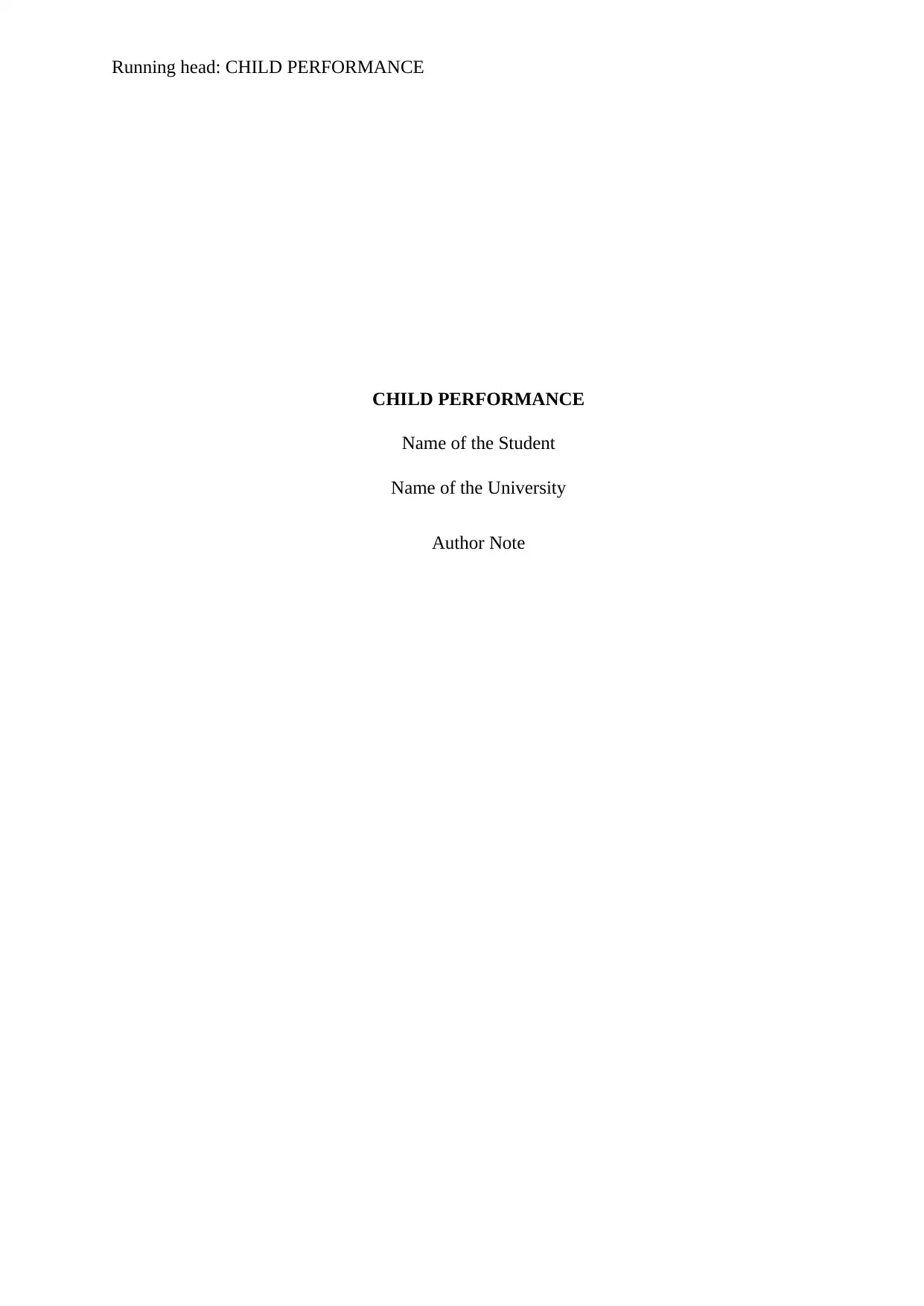
Running head: CHILD PERFORMANCE
CHILD PERFORMANCE
Name of the Student
Name of the University
Author Note
CHILD PERFORMANCE
Name of the Student
Name of the University
Author Note
Paraphrase This Document
Need a fresh take? Get an instant paraphrase of this document with our AI Paraphraser
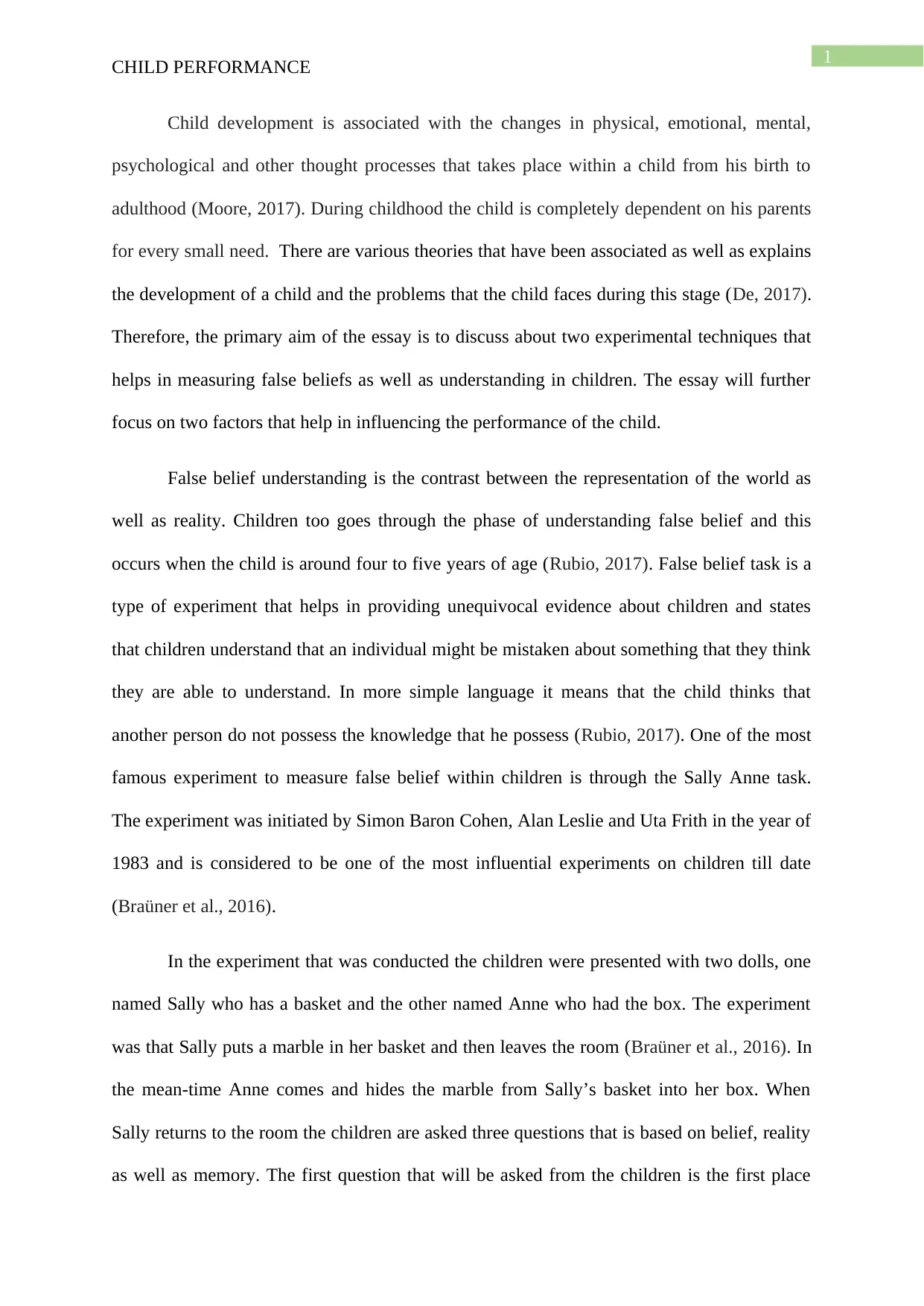
1
CHILD PERFORMANCE
Child development is associated with the changes in physical, emotional, mental,
psychological and other thought processes that takes place within a child from his birth to
adulthood (Moore, 2017). During childhood the child is completely dependent on his parents
for every small need. There are various theories that have been associated as well as explains
the development of a child and the problems that the child faces during this stage (De, 2017).
Therefore, the primary aim of the essay is to discuss about two experimental techniques that
helps in measuring false beliefs as well as understanding in children. The essay will further
focus on two factors that help in influencing the performance of the child.
False belief understanding is the contrast between the representation of the world as
well as reality. Children too goes through the phase of understanding false belief and this
occurs when the child is around four to five years of age (Rubio, 2017). False belief task is a
type of experiment that helps in providing unequivocal evidence about children and states
that children understand that an individual might be mistaken about something that they think
they are able to understand. In more simple language it means that the child thinks that
another person do not possess the knowledge that he possess (Rubio, 2017). One of the most
famous experiment to measure false belief within children is through the Sally Anne task.
The experiment was initiated by Simon Baron Cohen, Alan Leslie and Uta Frith in the year of
1983 and is considered to be one of the most influential experiments on children till date
(Braüner et al., 2016).
In the experiment that was conducted the children were presented with two dolls, one
named Sally who has a basket and the other named Anne who had the box. The experiment
was that Sally puts a marble in her basket and then leaves the room (Braüner et al., 2016). In
the mean-time Anne comes and hides the marble from Sally’s basket into her box. When
Sally returns to the room the children are asked three questions that is based on belief, reality
as well as memory. The first question that will be asked from the children is the first place
CHILD PERFORMANCE
Child development is associated with the changes in physical, emotional, mental,
psychological and other thought processes that takes place within a child from his birth to
adulthood (Moore, 2017). During childhood the child is completely dependent on his parents
for every small need. There are various theories that have been associated as well as explains
the development of a child and the problems that the child faces during this stage (De, 2017).
Therefore, the primary aim of the essay is to discuss about two experimental techniques that
helps in measuring false beliefs as well as understanding in children. The essay will further
focus on two factors that help in influencing the performance of the child.
False belief understanding is the contrast between the representation of the world as
well as reality. Children too goes through the phase of understanding false belief and this
occurs when the child is around four to five years of age (Rubio, 2017). False belief task is a
type of experiment that helps in providing unequivocal evidence about children and states
that children understand that an individual might be mistaken about something that they think
they are able to understand. In more simple language it means that the child thinks that
another person do not possess the knowledge that he possess (Rubio, 2017). One of the most
famous experiment to measure false belief within children is through the Sally Anne task.
The experiment was initiated by Simon Baron Cohen, Alan Leslie and Uta Frith in the year of
1983 and is considered to be one of the most influential experiments on children till date
(Braüner et al., 2016).
In the experiment that was conducted the children were presented with two dolls, one
named Sally who has a basket and the other named Anne who had the box. The experiment
was that Sally puts a marble in her basket and then leaves the room (Braüner et al., 2016). In
the mean-time Anne comes and hides the marble from Sally’s basket into her box. When
Sally returns to the room the children are asked three questions that is based on belief, reality
as well as memory. The first question that will be asked from the children is the first place
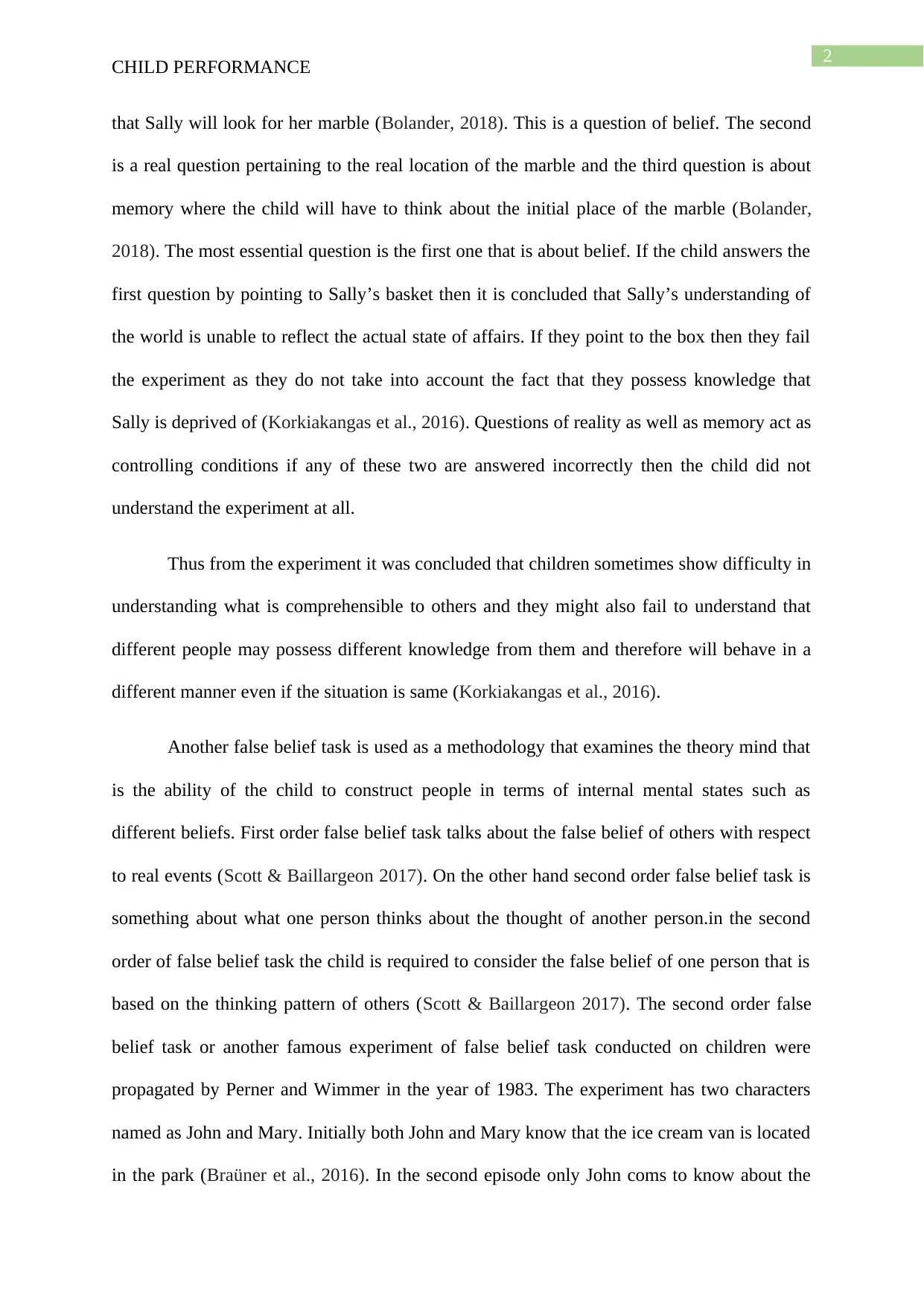
2
CHILD PERFORMANCE
that Sally will look for her marble (Bolander, 2018). This is a question of belief. The second
is a real question pertaining to the real location of the marble and the third question is about
memory where the child will have to think about the initial place of the marble (Bolander,
2018). The most essential question is the first one that is about belief. If the child answers the
first question by pointing to Sally’s basket then it is concluded that Sally’s understanding of
the world is unable to reflect the actual state of affairs. If they point to the box then they fail
the experiment as they do not take into account the fact that they possess knowledge that
Sally is deprived of (Korkiakangas et al., 2016). Questions of reality as well as memory act as
controlling conditions if any of these two are answered incorrectly then the child did not
understand the experiment at all.
Thus from the experiment it was concluded that children sometimes show difficulty in
understanding what is comprehensible to others and they might also fail to understand that
different people may possess different knowledge from them and therefore will behave in a
different manner even if the situation is same (Korkiakangas et al., 2016).
Another false belief task is used as a methodology that examines the theory mind that
is the ability of the child to construct people in terms of internal mental states such as
different beliefs. First order false belief task talks about the false belief of others with respect
to real events (Scott & Baillargeon 2017). On the other hand second order false belief task is
something about what one person thinks about the thought of another person.in the second
order of false belief task the child is required to consider the false belief of one person that is
based on the thinking pattern of others (Scott & Baillargeon 2017). The second order false
belief task or another famous experiment of false belief task conducted on children were
propagated by Perner and Wimmer in the year of 1983. The experiment has two characters
named as John and Mary. Initially both John and Mary know that the ice cream van is located
in the park (Braüner et al., 2016). In the second episode only John coms to know about the
CHILD PERFORMANCE
that Sally will look for her marble (Bolander, 2018). This is a question of belief. The second
is a real question pertaining to the real location of the marble and the third question is about
memory where the child will have to think about the initial place of the marble (Bolander,
2018). The most essential question is the first one that is about belief. If the child answers the
first question by pointing to Sally’s basket then it is concluded that Sally’s understanding of
the world is unable to reflect the actual state of affairs. If they point to the box then they fail
the experiment as they do not take into account the fact that they possess knowledge that
Sally is deprived of (Korkiakangas et al., 2016). Questions of reality as well as memory act as
controlling conditions if any of these two are answered incorrectly then the child did not
understand the experiment at all.
Thus from the experiment it was concluded that children sometimes show difficulty in
understanding what is comprehensible to others and they might also fail to understand that
different people may possess different knowledge from them and therefore will behave in a
different manner even if the situation is same (Korkiakangas et al., 2016).
Another false belief task is used as a methodology that examines the theory mind that
is the ability of the child to construct people in terms of internal mental states such as
different beliefs. First order false belief task talks about the false belief of others with respect
to real events (Scott & Baillargeon 2017). On the other hand second order false belief task is
something about what one person thinks about the thought of another person.in the second
order of false belief task the child is required to consider the false belief of one person that is
based on the thinking pattern of others (Scott & Baillargeon 2017). The second order false
belief task or another famous experiment of false belief task conducted on children were
propagated by Perner and Wimmer in the year of 1983. The experiment has two characters
named as John and Mary. Initially both John and Mary know that the ice cream van is located
in the park (Braüner et al., 2016). In the second episode only John coms to know about the
⊘ This is a preview!⊘
Do you want full access?
Subscribe today to unlock all pages.

Trusted by 1+ million students worldwide
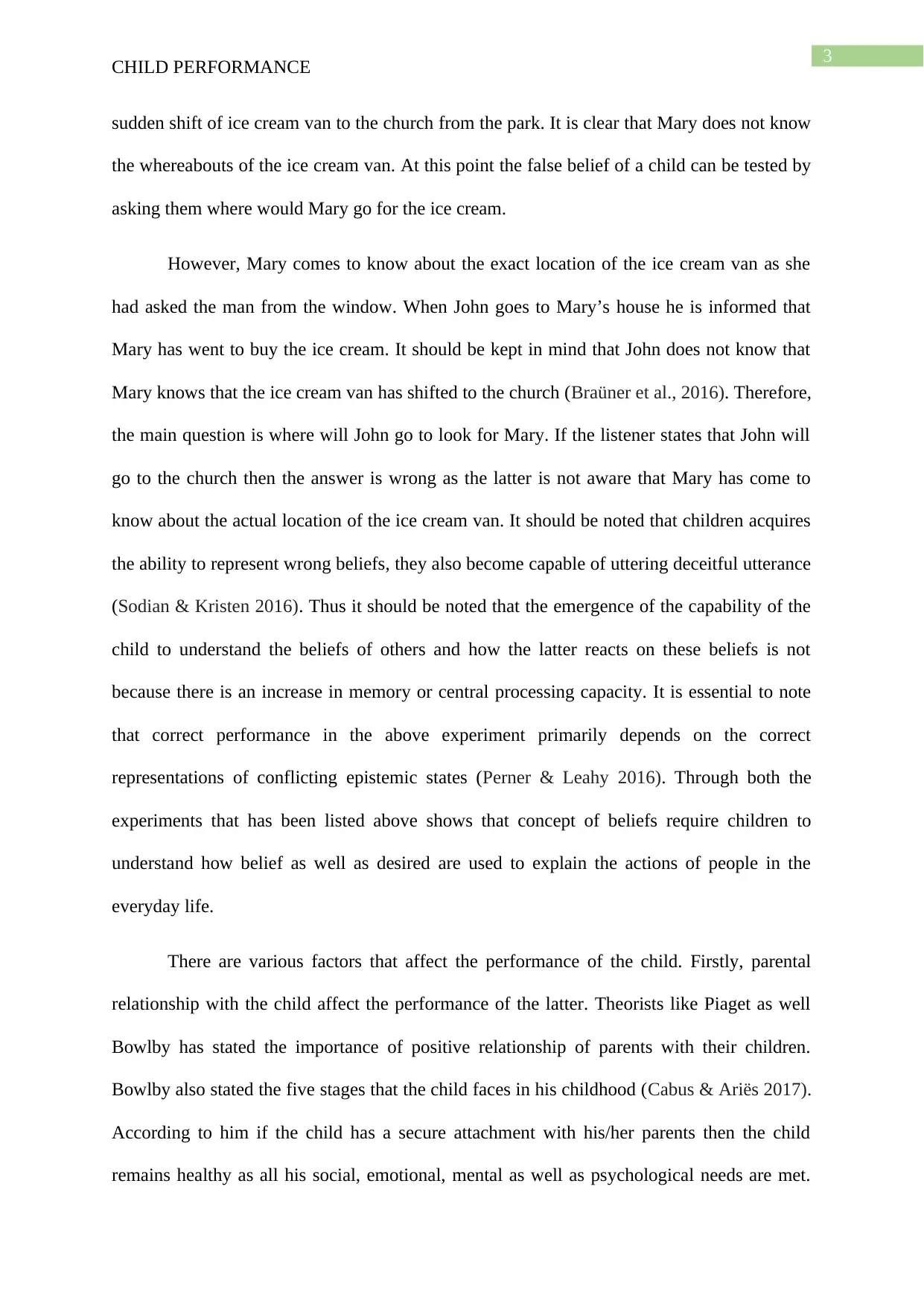
3
CHILD PERFORMANCE
sudden shift of ice cream van to the church from the park. It is clear that Mary does not know
the whereabouts of the ice cream van. At this point the false belief of a child can be tested by
asking them where would Mary go for the ice cream.
However, Mary comes to know about the exact location of the ice cream van as she
had asked the man from the window. When John goes to Mary’s house he is informed that
Mary has went to buy the ice cream. It should be kept in mind that John does not know that
Mary knows that the ice cream van has shifted to the church (Braüner et al., 2016). Therefore,
the main question is where will John go to look for Mary. If the listener states that John will
go to the church then the answer is wrong as the latter is not aware that Mary has come to
know about the actual location of the ice cream van. It should be noted that children acquires
the ability to represent wrong beliefs, they also become capable of uttering deceitful utterance
(Sodian & Kristen 2016). Thus it should be noted that the emergence of the capability of the
child to understand the beliefs of others and how the latter reacts on these beliefs is not
because there is an increase in memory or central processing capacity. It is essential to note
that correct performance in the above experiment primarily depends on the correct
representations of conflicting epistemic states (Perner & Leahy 2016). Through both the
experiments that has been listed above shows that concept of beliefs require children to
understand how belief as well as desired are used to explain the actions of people in the
everyday life.
There are various factors that affect the performance of the child. Firstly, parental
relationship with the child affect the performance of the latter. Theorists like Piaget as well
Bowlby has stated the importance of positive relationship of parents with their children.
Bowlby also stated the five stages that the child faces in his childhood (Cabus & Ariës 2017).
According to him if the child has a secure attachment with his/her parents then the child
remains healthy as all his social, emotional, mental as well as psychological needs are met.
CHILD PERFORMANCE
sudden shift of ice cream van to the church from the park. It is clear that Mary does not know
the whereabouts of the ice cream van. At this point the false belief of a child can be tested by
asking them where would Mary go for the ice cream.
However, Mary comes to know about the exact location of the ice cream van as she
had asked the man from the window. When John goes to Mary’s house he is informed that
Mary has went to buy the ice cream. It should be kept in mind that John does not know that
Mary knows that the ice cream van has shifted to the church (Braüner et al., 2016). Therefore,
the main question is where will John go to look for Mary. If the listener states that John will
go to the church then the answer is wrong as the latter is not aware that Mary has come to
know about the actual location of the ice cream van. It should be noted that children acquires
the ability to represent wrong beliefs, they also become capable of uttering deceitful utterance
(Sodian & Kristen 2016). Thus it should be noted that the emergence of the capability of the
child to understand the beliefs of others and how the latter reacts on these beliefs is not
because there is an increase in memory or central processing capacity. It is essential to note
that correct performance in the above experiment primarily depends on the correct
representations of conflicting epistemic states (Perner & Leahy 2016). Through both the
experiments that has been listed above shows that concept of beliefs require children to
understand how belief as well as desired are used to explain the actions of people in the
everyday life.
There are various factors that affect the performance of the child. Firstly, parental
relationship with the child affect the performance of the latter. Theorists like Piaget as well
Bowlby has stated the importance of positive relationship of parents with their children.
Bowlby also stated the five stages that the child faces in his childhood (Cabus & Ariës 2017).
According to him if the child has a secure attachment with his/her parents then the child
remains healthy as all his social, emotional, mental as well as psychological needs are met.
Paraphrase This Document
Need a fresh take? Get an instant paraphrase of this document with our AI Paraphraser
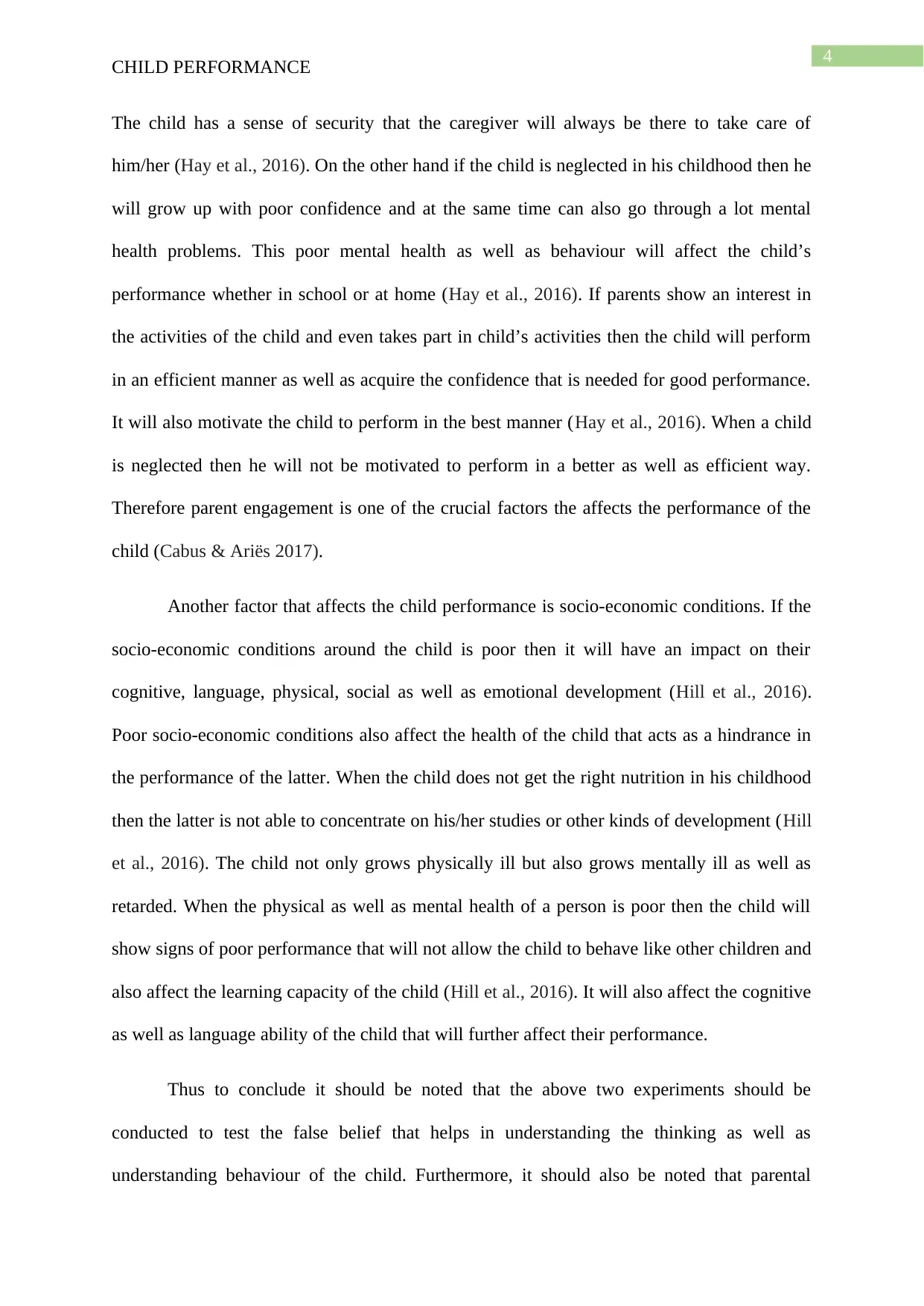
4
CHILD PERFORMANCE
The child has a sense of security that the caregiver will always be there to take care of
him/her (Hay et al., 2016). On the other hand if the child is neglected in his childhood then he
will grow up with poor confidence and at the same time can also go through a lot mental
health problems. This poor mental health as well as behaviour will affect the child’s
performance whether in school or at home (Hay et al., 2016). If parents show an interest in
the activities of the child and even takes part in child’s activities then the child will perform
in an efficient manner as well as acquire the confidence that is needed for good performance.
It will also motivate the child to perform in the best manner (Hay et al., 2016). When a child
is neglected then he will not be motivated to perform in a better as well as efficient way.
Therefore parent engagement is one of the crucial factors the affects the performance of the
child (Cabus & Ariës 2017).
Another factor that affects the child performance is socio-economic conditions. If the
socio-economic conditions around the child is poor then it will have an impact on their
cognitive, language, physical, social as well as emotional development (Hill et al., 2016).
Poor socio-economic conditions also affect the health of the child that acts as a hindrance in
the performance of the latter. When the child does not get the right nutrition in his childhood
then the latter is not able to concentrate on his/her studies or other kinds of development (Hill
et al., 2016). The child not only grows physically ill but also grows mentally ill as well as
retarded. When the physical as well as mental health of a person is poor then the child will
show signs of poor performance that will not allow the child to behave like other children and
also affect the learning capacity of the child (Hill et al., 2016). It will also affect the cognitive
as well as language ability of the child that will further affect their performance.
Thus to conclude it should be noted that the above two experiments should be
conducted to test the false belief that helps in understanding the thinking as well as
understanding behaviour of the child. Furthermore, it should also be noted that parental
CHILD PERFORMANCE
The child has a sense of security that the caregiver will always be there to take care of
him/her (Hay et al., 2016). On the other hand if the child is neglected in his childhood then he
will grow up with poor confidence and at the same time can also go through a lot mental
health problems. This poor mental health as well as behaviour will affect the child’s
performance whether in school or at home (Hay et al., 2016). If parents show an interest in
the activities of the child and even takes part in child’s activities then the child will perform
in an efficient manner as well as acquire the confidence that is needed for good performance.
It will also motivate the child to perform in the best manner (Hay et al., 2016). When a child
is neglected then he will not be motivated to perform in a better as well as efficient way.
Therefore parent engagement is one of the crucial factors the affects the performance of the
child (Cabus & Ariës 2017).
Another factor that affects the child performance is socio-economic conditions. If the
socio-economic conditions around the child is poor then it will have an impact on their
cognitive, language, physical, social as well as emotional development (Hill et al., 2016).
Poor socio-economic conditions also affect the health of the child that acts as a hindrance in
the performance of the latter. When the child does not get the right nutrition in his childhood
then the latter is not able to concentrate on his/her studies or other kinds of development (Hill
et al., 2016). The child not only grows physically ill but also grows mentally ill as well as
retarded. When the physical as well as mental health of a person is poor then the child will
show signs of poor performance that will not allow the child to behave like other children and
also affect the learning capacity of the child (Hill et al., 2016). It will also affect the cognitive
as well as language ability of the child that will further affect their performance.
Thus to conclude it should be noted that the above two experiments should be
conducted to test the false belief that helps in understanding the thinking as well as
understanding behaviour of the child. Furthermore, it should also be noted that parental
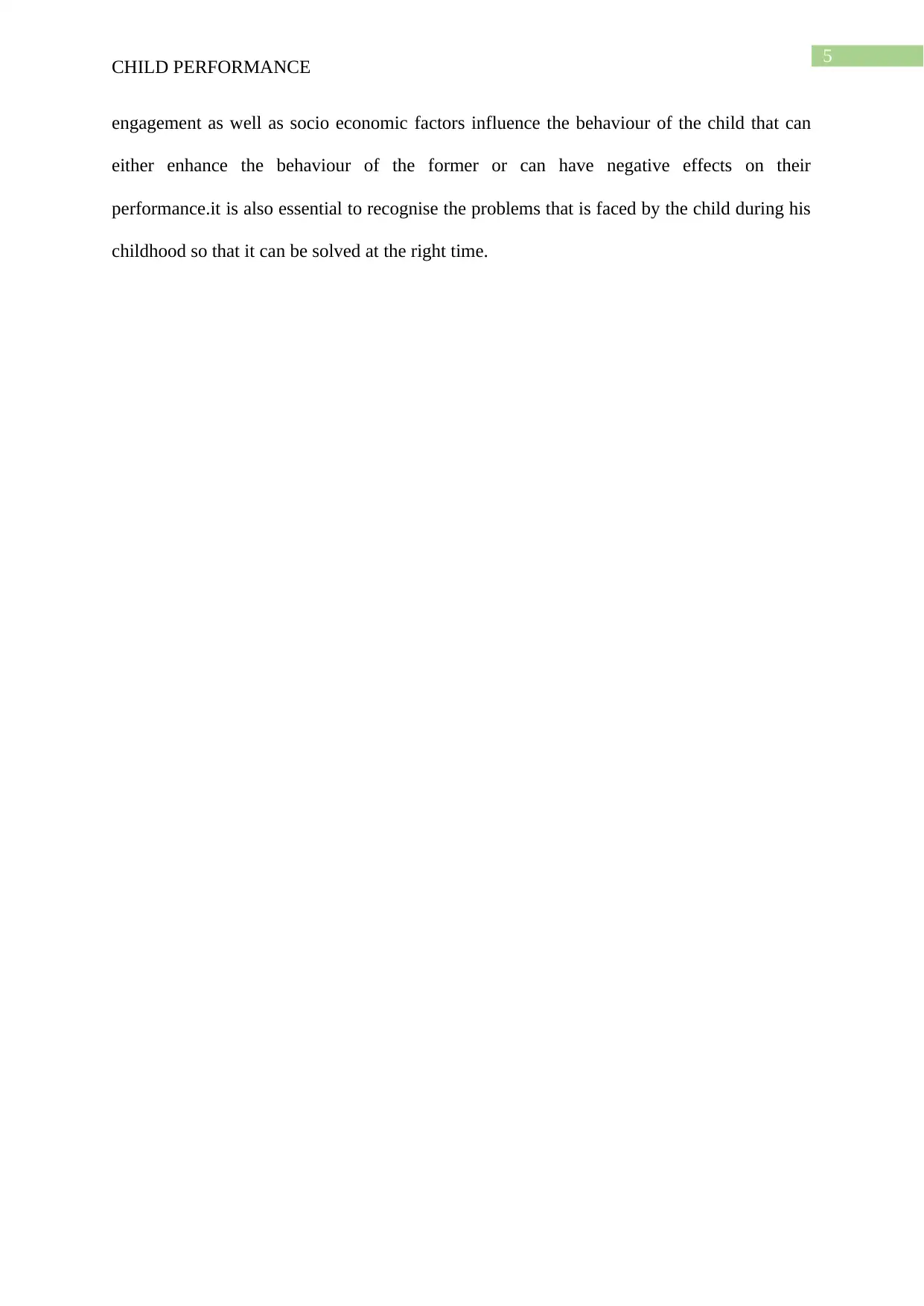
5
CHILD PERFORMANCE
engagement as well as socio economic factors influence the behaviour of the child that can
either enhance the behaviour of the former or can have negative effects on their
performance.it is also essential to recognise the problems that is faced by the child during his
childhood so that it can be solved at the right time.
CHILD PERFORMANCE
engagement as well as socio economic factors influence the behaviour of the child that can
either enhance the behaviour of the former or can have negative effects on their
performance.it is also essential to recognise the problems that is faced by the child during his
childhood so that it can be solved at the right time.
⊘ This is a preview!⊘
Do you want full access?
Subscribe today to unlock all pages.

Trusted by 1+ million students worldwide
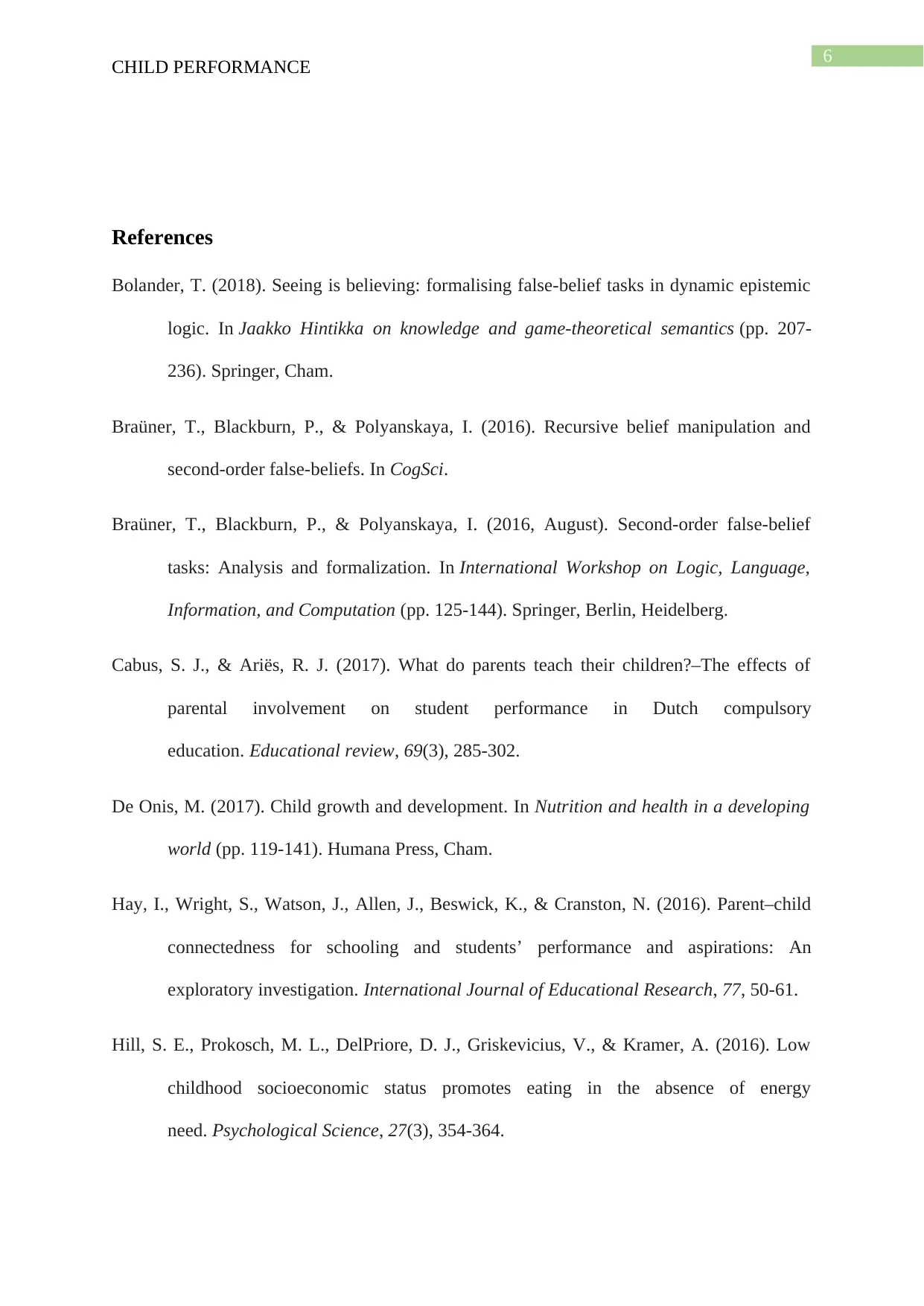
6
CHILD PERFORMANCE
References
Bolander, T. (2018). Seeing is believing: formalising false-belief tasks in dynamic epistemic
logic. In Jaakko Hintikka on knowledge and game-theoretical semantics (pp. 207-
236). Springer, Cham.
Braüner, T., Blackburn, P., & Polyanskaya, I. (2016). Recursive belief manipulation and
second-order false-beliefs. In CogSci.
Braüner, T., Blackburn, P., & Polyanskaya, I. (2016, August). Second-order false-belief
tasks: Analysis and formalization. In International Workshop on Logic, Language,
Information, and Computation (pp. 125-144). Springer, Berlin, Heidelberg.
Cabus, S. J., & Ariës, R. J. (2017). What do parents teach their children?–The effects of
parental involvement on student performance in Dutch compulsory
education. Educational review, 69(3), 285-302.
De Onis, M. (2017). Child growth and development. In Nutrition and health in a developing
world (pp. 119-141). Humana Press, Cham.
Hay, I., Wright, S., Watson, J., Allen, J., Beswick, K., & Cranston, N. (2016). Parent–child
connectedness for schooling and students’ performance and aspirations: An
exploratory investigation. International Journal of Educational Research, 77, 50-61.
Hill, S. E., Prokosch, M. L., DelPriore, D. J., Griskevicius, V., & Kramer, A. (2016). Low
childhood socioeconomic status promotes eating in the absence of energy
need. Psychological Science, 27(3), 354-364.
CHILD PERFORMANCE
References
Bolander, T. (2018). Seeing is believing: formalising false-belief tasks in dynamic epistemic
logic. In Jaakko Hintikka on knowledge and game-theoretical semantics (pp. 207-
236). Springer, Cham.
Braüner, T., Blackburn, P., & Polyanskaya, I. (2016). Recursive belief manipulation and
second-order false-beliefs. In CogSci.
Braüner, T., Blackburn, P., & Polyanskaya, I. (2016, August). Second-order false-belief
tasks: Analysis and formalization. In International Workshop on Logic, Language,
Information, and Computation (pp. 125-144). Springer, Berlin, Heidelberg.
Cabus, S. J., & Ariës, R. J. (2017). What do parents teach their children?–The effects of
parental involvement on student performance in Dutch compulsory
education. Educational review, 69(3), 285-302.
De Onis, M. (2017). Child growth and development. In Nutrition and health in a developing
world (pp. 119-141). Humana Press, Cham.
Hay, I., Wright, S., Watson, J., Allen, J., Beswick, K., & Cranston, N. (2016). Parent–child
connectedness for schooling and students’ performance and aspirations: An
exploratory investigation. International Journal of Educational Research, 77, 50-61.
Hill, S. E., Prokosch, M. L., DelPriore, D. J., Griskevicius, V., & Kramer, A. (2016). Low
childhood socioeconomic status promotes eating in the absence of energy
need. Psychological Science, 27(3), 354-364.
Paraphrase This Document
Need a fresh take? Get an instant paraphrase of this document with our AI Paraphraser
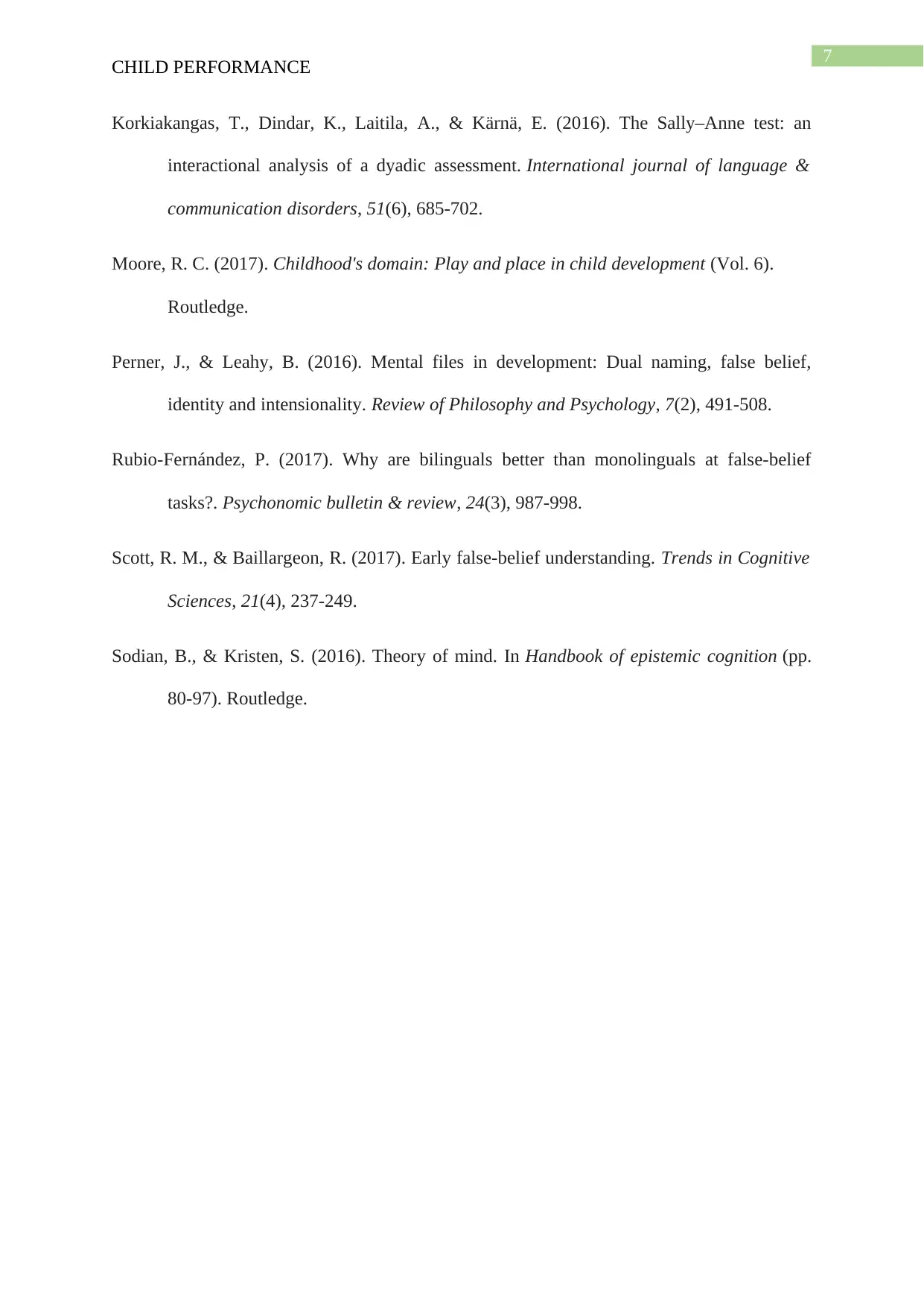
7
CHILD PERFORMANCE
Korkiakangas, T., Dindar, K., Laitila, A., & Kärnä, E. (2016). The Sally–Anne test: an
interactional analysis of a dyadic assessment. International journal of language &
communication disorders, 51(6), 685-702.
Moore, R. C. (2017). Childhood's domain: Play and place in child development (Vol. 6).
Routledge.
Perner, J., & Leahy, B. (2016). Mental files in development: Dual naming, false belief,
identity and intensionality. Review of Philosophy and Psychology, 7(2), 491-508.
Rubio-Fernández, P. (2017). Why are bilinguals better than monolinguals at false-belief
tasks?. Psychonomic bulletin & review, 24(3), 987-998.
Scott, R. M., & Baillargeon, R. (2017). Early false-belief understanding. Trends in Cognitive
Sciences, 21(4), 237-249.
Sodian, B., & Kristen, S. (2016). Theory of mind. In Handbook of epistemic cognition (pp.
80-97). Routledge.
CHILD PERFORMANCE
Korkiakangas, T., Dindar, K., Laitila, A., & Kärnä, E. (2016). The Sally–Anne test: an
interactional analysis of a dyadic assessment. International journal of language &
communication disorders, 51(6), 685-702.
Moore, R. C. (2017). Childhood's domain: Play and place in child development (Vol. 6).
Routledge.
Perner, J., & Leahy, B. (2016). Mental files in development: Dual naming, false belief,
identity and intensionality. Review of Philosophy and Psychology, 7(2), 491-508.
Rubio-Fernández, P. (2017). Why are bilinguals better than monolinguals at false-belief
tasks?. Psychonomic bulletin & review, 24(3), 987-998.
Scott, R. M., & Baillargeon, R. (2017). Early false-belief understanding. Trends in Cognitive
Sciences, 21(4), 237-249.
Sodian, B., & Kristen, S. (2016). Theory of mind. In Handbook of epistemic cognition (pp.
80-97). Routledge.
1 out of 8
Your All-in-One AI-Powered Toolkit for Academic Success.
+13062052269
info@desklib.com
Available 24*7 on WhatsApp / Email
![[object Object]](/_next/static/media/star-bottom.7253800d.svg)
Unlock your academic potential
Copyright © 2020–2025 A2Z Services. All Rights Reserved. Developed and managed by ZUCOL.


